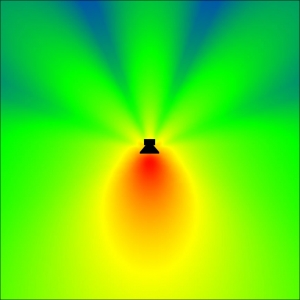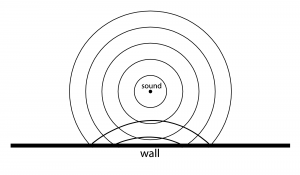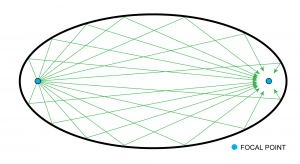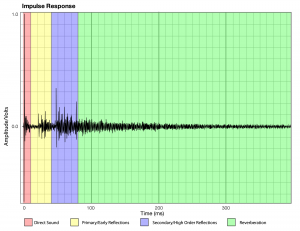Sometimes it’s convenient to simplify our understanding of sound by considering how it behaves when there is nothing in the environment to impede it. An environment with no physical influences to absorb, reflect, diffract, refract, reverberate, resonate, or diffuse sound is called a free field. A free field is an idealization of real world conditions that facilitates our analysis of how sound behaves. Sound in a free field can be pictured as radiating out from a point source, diminishing in intensity as it gets farther from the source. A free field is partially illustrated in Figure 4.18. In this figure, sound is radiating out from a loudspeaker, with the colors indicating highest to lowest intensity sound in the order red, orange, yellow, green, and blue. The area in front of the loudspeaker might be considered a free field. However, because the loudspeaker partially blocks the sound from going behind itself, the sound is lower in amplitude there. You can see that there is some sound behind the loudspeaker, resulting from reflection and diffraction.

4.1.7.1 Absorption, Reflection, Refraction, and Diffraction
In the real world, there are any number of things that can get in the way of sound, changing its direction, amplitude, and frequency components. In enclosed spaces, absorption plays an important role. Sound absorption is the conversion of sound’s energy into heat, thereby diminishing the intensity of the sound. The diminishing of sound intensity is called attenuation. A general mathematical formulation for the way sound attenuates as it moves through the air is captured in the inverse square law, which shows that sound decreases in intensity in proportion to the square of the distance from the source. (See Section 4.2.1.6.) The attenuation of sound in the air is due to the air molecules themselves absorbing and converting some of the energy to heat. The amount of attenuation depends in part on the air temperature and relative humidity. Thick, porous materials can absorb and attenuate the sound even further, and they’re often used in architectural treatments to modify and control the acoustics of a room. Even hard, solid surfaces absorb some of the sound energy, although most of it is reflected back. The material of walls and ceilings, the number and material of seats, the number of persons in an audience, and all solid objects have to be taken into consideration acoustically in sound setups for live performance spaces.
Sound that is not absorbed by objects is instead reflected from, diffracted around, or refracted into the object. Hard surfaces reflect sound more than soft ones, which are more absorbent. The law of reflection states that the angle of incidence of a wave is equal to the angle of reflection. This means that if a wave were to propagate in a straight line from its source, it reflects in the way pictured in Figure 4.15. In reality, however, sound radiates out spherically from its source. Thus, a wavefront of sound approaches objects and surfaces from various angles. Imagine a cross-section of the moving wavefront approaching a straight wall, as seen from above. Its reflection would be as pictured in Figure 4.15, like a mirror reflection.


In a special case, if the wavefront were to approach a concave curved solid surface, it would be reflected back to converge at one point in the room, the location of that point depending on the angle of the curve. This is how whispering rooms are constructed, such that two people whispering in the room can hear each other perfectly if they’re positioned at the sound’s focal points, even though the focal points may be at the far opposite ends of the room. A person positioned elsewhere in the room cannot hear their whispers at all. A common shape found with whispering rooms is an ellipse, as seen in Figure 4.16. The shape and curve of these walls cause any and all sound emanating from one focal point to reflect directly to the other.

[aside]
Diffraction also has a lot to do with microphone and loudspeaker directivity. Consider how microphones often have different polar patterns at different frequencies. Even with a directional mic, you’ll often see lower frequencies behave more omnidirectionally, and sometimes an omnidirectional mic may be more directional at high frequencies. That’s largely because of the size of the wavelength compared to size of the microphone diaphragm. It’s hard for high frequencies to diffract around a larger object, so for a mic to have a truly omnidirectional pattern, the diaphragm has to be very small.
[/aside]
Diffraction is the bending of a sound wave as it moves past an obstacle or through a narrow opening. The phenomenon of diffraction allows us to hear sounds from sources that are not in direct line-of-sight, such as a person standing around a corner or on the other side of a partially obstructing object. The amount of diffraction is dependent on the relationship between the size of the obstacle and the size of the sound’s wavelength. Low frequency sounds (i.e., long-wavelength sounds) are diffracted more than high frequencies (i.e., short wavelengths) around the same obstacle. In other words, low frequency sounds are better able to travel around obstacles. In fact, if the wavelength of a sound is significantly larger than an obstacle that the sound encounters, the sound wave continues as if the obstacle isn’t even there. For example, your stereo speaker drivers are probably protected behind a plastic or metal grill, yet the sound passes through it intact and without noticeable coloration. The obstacle presented by the wire mesh of the grill (perhaps a millimeter or two in diameter) is even smaller than the smallest wavelength we can hear (about 2 centimeters for 20 kHz, 10 to 20 times larger than the wire), so the sound diffracts easily around it.
Refraction is the bending of a sound wave as it moves through different media. Typically we think of refraction with light waves, as when we look at something through glass or that is underwater. In acoustics, the refraction of sound waves tends to be more gradual, as the properties of the air change subtly over longer distances. This causes a bending in sound waves over a long distance, primarily due to temperature, humidity, and in some cases wind gradients over distance and altitude. This bending can result in noticeable differences in sound levels, either as a boost or an attenuation, also referred to as a shadow zone.
4.1.7.2 Reverberation, Echo, Diffusion, and Resonance
Reverberation is the result of sound waves reflecting off of many objects or surfaces in the environment. Imagine an indoor room in which you make a sudden burst of sound. Some of that sound is transmitted through or absorbed by the walls or objects, and the rest is reflected back, bouncing off the walls, ceilings, and other surfaces in the room. The sound wave that travels straight from the sound source to your ears is called the direct signal. The first few instances of reflected sound are called primary or early reflections. Early reflections arrive at your ears about 60 ms or sooner after the direct sound, and play a large part in imparting a sense of space and room size to the human ear. Early reflections may be followed by a handful of secondary and higher-order reflections. At this point, the sound waves have had plenty of opportunity to bounce off of multiple surfaces, multiple times. As a result, the reflections that are arriving now are more numerous, closer together in time, and quieter. Much of the initial energy initial energy of the reflections has been absorbed by surfaces or expended in the distance traveled through the air. This dense collection of reflections is reverberation, illustrated in Figure 4.17. Assuming that the sound source is only momentary, the generated sound eventually decays as the waves lose energy, the reverberation becoming less and less loud until the sound is no longer discernable. Typically, reverberation time is defined as the time it takes for the sound to decay in level by 60 dB from its direct signal.

Single, strong reflections that reach the ear a significant amount of time – about 100 ms – after the direct signal can be perceived as an echo – essentially a separate recurrence of the original sound. Even reflections as little as 50 ms apart can cause an audible echo, depending on the type of sound and room acoustics. While echo is often employed artistically in music recordings, echoes tend to be detrimental and distracting in a live setting and are usually avoided or require remediation in performance and listening spaces.
Diffusion is another property that interacts with reflections and reverberation. Diffusion relates to the ability to distribute sound energy more evenly in a listening space. While a flat, even surface reflects sounds strongly in a predictable direction, uneven surfaces or convex curved surfaces diffuse sound more randomly and evenly. Like absorption, diffusion is often used to treat a space acoustically to help break up harsh reflections that interfere with the natural sound. Unlike absorption, however, which attempts to eliminate the unwanted sound waves by reducing the sound energy, diffusion attempts to redirect the sound waves in a more natural manner. A room with lots of absorption has less overall reverberation, while diffusion maintains the sound’s intensity and helps turn harsh reflections into more pleasant reverberation. Usually a combination of absorption and diffusion is employed to achieve the optimal result. There are many unique types of diffusing surfaces and panels that are manufactured based on mathematical algorithms to provide the most random, diffuse reflections possible
Putting these concepts together, we can say that the amount of time it takes for a particular sound to decay depends on the size and shape of the room, its diffusive properties, and the absorptive properties of the walls, ceilings, and objects in the room. In short, all the aforementioned properties determine how sound reverberates in a space, giving the listener a “sense of place.”
Reverberation in an auditorium can enhance the listener’s experience, particularly in the case of a music hall where it gives the individual sounds a richer quality and helps them blend together. Excessive reverberation, however, can reduce intelligibility and make it difficult to understand speech. In Chapter 7, you’ll see how artificial reverberation is applied in audio processing.
A final important acoustical property to be considered is resonance. In Chapter 2, we defined resonance as an object’s tendency to vibrate or oscillate at a certain frequency that is basic to its nature. Like a musical instrument, a room has a set of resonant frequencies, called its room modes. Room modes result in locations in a room where certain frequencies are boosted or attenuated, making it difficult to give all listeners the same audio experience. We’ll talk more about how to deal with room modes in Section 4.2.2.5.